This presentation was made at CIBJO Congress 2017 in Bangkok, Thailand by Justin Hunter of J Hunter Pearls, Fiji. CIBJO is The World Jewellery Confederation - a worldwide body which promotes Global Cooperation, Harmonization and Corporate Social Responsibility.
---------------------------------------------------------------------------------------
On June 7th, 2017 at the UN Oceans Conference in New York the Honorable Prime Minister Josaia Voreqe Bainimarama and Minister of Fisheries, Captain Semi Koroilavesau affirmed the Fiji Government’s sixteen voluntary commitments towards the implementation of Sustainable Development Goal 14 (SG14) and its associated targets.
Commitment # 2 - Creating a Blue Industry “Sustainable Luxury” - specifically recognized the sustainable initiatives of Fiji’s Pearl Industry and the Fiji Government’s support in developing the industry through community owned and operated farms as a means of providing tangible economic benefits for coastal indigenous communities.
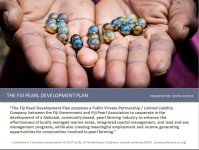
This commitment was welcomed by The World Jewellery Confederation (CIBJO), the international authority of gems, jewellery and precious metals, with CIBJO President, Gaetano Cavalieri, invited to speak alongside Fijian pearl farmer Justin Hunter who introduced the Fiji Pearl Development Plan to the side panel audience in New York during the Oceans Conference.
The World Jewellery Confederation (CIBJO) represents national jewellery trade organizations and commercial industry bodies of more then 40 countries. In 2006, CIBJO became the only organization in the international diamond, gemstone and jewellery sectors ever to receive official consultative status with the Economic and Social Council (ECOSOC) of the United Nations. Based on Article 71 of the UN Charter, the status enables CIBJO, on behalf of the international gemstone and jewellery industries, to advance the programs and goals of the United Nations by serving as a technical expert, adviser and consultant to governments and the UN Secretariat.

Polar migration of temperate fish species while tropical species migration means they will have a much wider range and therefor critical for world wide food security as sea temperatures increase.
There will be “winner and losers” as sea temperature's increase – and those from warmer waters have a greater chance of evolving then those cooler water species.
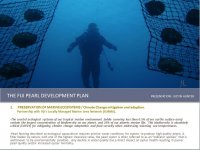
Preservation of Marine Ecosystems.
-Partnering with Fiji’s Locally Managed Marine Area Network (FLMMA) to address UN SDG14.
Coral reefs and marine areas that include mangroves, seaweed, algae and sea grasses, also play a crucial role in offsetting carbon emissions as these habitats act as “blue carbon sinks” holding up to five times more carbon then green carbon sinks (rainforests).
Any decline in water quality has a direct impact on oyster health resulting in poorer pearl quality and/or increased oyster mortality. Pearl farms in this regard serve as important regulators of water quality as pearl farmers naturally adopt the role of sea stewards to protect their investment.
Through the engagement of indigenous communities in pearl farming and the adoption of local knowledge and inherent governing/ institutional structures, the plan provides a model for effective conservation, offering tangible economic benefits in return for marine preservation with a long term goal of future generations taking up the role of being Stewards of the Sea.
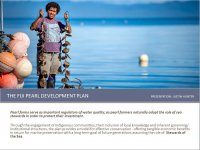
2. Social and Economic Sustainability. Greatest threat to our environment is poverty.
A key concern for Locally Managed Marine Areas, Integrated Coastal Management Programs and Marine Protected Area’s is in finding the balance between conservation and economics so both man & nature benefit.
Indigenous communities, with a specific focus on women and youth, will directly benefit from the establishment of these community owned farms through employment, capacity building and eventually income generated from pearl revenues. This alternative source of income will furthermore create added incentives for conservation by reducing pressure on fish stocks creating a culture of resource preservations rather then resource extraction.
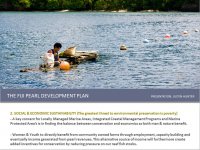
3. A Sustainable Luxury Model for Fiji & the World.
There are very few products, especially in the luxury market, that make an impact in conservation and specifically SDG14 as the cultured pearl. Organic by nature, and the only gem that is formed inside the body of a living animal its allure comes from deep within.
The success of any pearl industry is based on finding the perfect relationship between Man and Nature. With the partnering of all vested stakeholders we believe this industry can grow to be an example for not just the luxury sector but also other local industries. The unique story of our ocean gem will set a new benchmark for sustainable luxury on a global platform, appealing to the upcoming generation of ethical shoppers. The Fiji Pearl brand will put Fiji on the world map as producers of sustainable luxury, cultivators of the worlds only true sustainable gem.
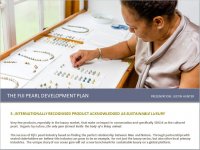
With some duplication, here is the The Fiji Pearl Development Plan Executive Summary:
On June 7th, 2017 at the UN Oceans Conference in New York the Honorable Prime Minister Josaia Voreqe Bainimarama and Minister of Fisheries, Captain Semi Koroilavesau affirmed the Fiji Government’s sixteen voluntary commitments towards the implementation of Sustainable Development Goal 14 (SG14) and its associated targets.
Commitment # 2 - Creating a Blue Industry “Sustainable Luxury” - specifically recognized the sustainable initiatives of Fiji’s Pearl Industry and the Fiji Government’s support in developing the industry through community owned and operated farms as a means of providing tangible economic benefits for coastal indigenous communities.
“The Fiji Pearl Development Plan proposes a Public Private Partnership / Limited Liability Company between the Fiji Government and Fiji Pearl Association to cooperate in the development of a National, community-based, pearl farming industry to enhance the effectiveness of locally managed marine areas, integrated coastal management, and land and sea management programs, while also creating meaningful employment and income generating opportunities for communities involved in pearl farming.” – Commitment 2, Summary (oceanconference.un.org/commitments/?id=19864)
This commitment was welcomed by The World Jewellery Confederation (CIBJO), the international authority of gems, jewellery and precious metals, with CIBJO President, Gaetano Cavalieri, invited to speak alongside Fijian pearl farmer Justin Hunter who introduced the Fiji Pearl Development Plan to the side panel audience in New York during the Oceans Conference.
“The Public Private Partnership being proposed in Fiji offers the promise of building an industry, from the grass roots up, founded on a sustainable and valuable product that is supported by responsible and sustainable environmental practices. Just as the potential economic and social benefits to the country are dependent upon a viable business model, the business model requires an economic environment in which all stakeholders feel they are benefiting. The one goes hand in hand with the other. And this is all only possible over the long-term if the marine environment is responsibly managed. It is the very epitome of a win-win-win situation.” –Gaetano Cavalieri
(www.jewellerynewsasia.com/news-cont...ts-sustainable-pearl-farming-at-un-conference)
The Fiji Pearl Development Plan outlines a strategic approach to achieving the following:
1. Preservation of Marine Ecosystems.
-Partnering with Fiji’s Locally Managed Marine Area Network (FLMMA) to address UN SDG14.
Coral reefs, the most diverse of all marine ecosystems, and home of the Fijian pearl oyster, face huge threats in the face of climate change and its associated effects on ocean warming, ocean acidification and coral bleaching.
The coastal ecological systems of our tropical marine environment (while covering less then 0.5% of our earths surface area) contain the largest concentration of biodiversity on our planet, and 25% of our planets marine life. The vast biodiversity of our tropical marine environment is absolutely critical to our entire planets ability to adapt and mitigate the impact of Climate Change. Increasing sea temperatures will result in “polar migration” of todays temperate fish species, creating worldwide food security issues, that will rely heavily on our tropical species to address.
Coral reefs and marine areas that include mangroves, seaweed, algae and sea grasses, also play a crucial role in offsetting carbon emissions as these habitats act as “blue carbon sinks” holding up to five times more carbon then green carbon sinks (rainforests).
Pearl farming described as ecological aquaculture requiring pristine water conditions for oysters to produce high quality pearls. A filter feeder by nature, with one of the highest clearance rates, the pearl oyster is often referred to as an “indicator species” that is well known to be environmentally sensitive. Any decline in water quality has a direct impact on oyster health resulting in poorer pearl quality and/or increased oyster mortality. Pearl farms in this regard serve as important regulators of water quality as pearl farmers naturally adopt the role of sea stewards to protect their investment.
Through the engagement of indigenous communities in pearl farming and the adoption of local knowledge and inherent governing/ institutional structures, the plan provides a model for effective conservation, offering tangible economic benefits in return for marine preservation with a long term goal of future generations taking up the role of being Stewards of the Sea.
2. Social and Economic Sustainability. (The greatest threat to our Environment is poverty.)
A key concern for Locally Managed Marine Areas, Integrated Coastal Management Programs and Marine Protected Area’s is in finding the balance between conservation and economics so both man & nature benefit.
Indigenous communities, with a specific focus on women and youth, will directly benefit from the establishment of these community owned farms through employment, capacity building and eventually income generated from pearl revenues. This alternative source of income will furthermore create added incentives for conservation by reducing pressure on our reef fish stocks. Through these tangible returns pearl farming communities will consequently understand the significant importance and value in preserving their marine ecosystems growing a culture of resource preservation rather than one of resource extraction.
2. A Sustainable Luxury Model for Fiji & the World.
There are very few products, especially in the luxury market, that make an impact in conservation and specifically SDG14 as the cultured pearl. Organic by nature, and the only gem that is formed inside the body of a living animal its allure comes from deep within.
The success of any pearl industry is based on finding the perfect relationship between Man and Nature. With the partnering of all vested stakeholders we believe this industry can grow to be an example for not just the luxury sector but also other local industries. The unique story of our ocean gem will set a new benchmark for sustainable luxury on a global platform, appealing to the upcoming generation of ethical shoppers. The Fiji Pearl brand will put Fiji on the world map as producers of sustainable luxury, cultivators of the worlds only true sustainable gem.
Other SDG Goals addressed:
SDG1 End poverty in all its forms everywhere.
SDG5 Achieve gender equality and empower all women and girls.
SDG8 Promote inclusive and sustainable economic growth, employment and decent work for all.
SDG10 Reduce inequality within and among countries.
SDG12 Ensure sustainable consumption and production patterns.
SDG13 Take urgent action to combat climate change and its impacts.
The World Jewellery Confederation (CIBJO) represents national jewellery trade organizations and commercial industry bodies of more then 40 countries. In 2006, CIBJO became the only organization in the international diamond, gemstone and jewellery sectors ever to receive official consultative status with the Economic and Social Council (ECOSOC) of the United Nations. Based on Article 71 of the UN Charter, the status enables CIBJO, on behalf of the international gemstone and jewellery industries, to advance the programs and goals of the United Nations by serving as a technical expert, adviser and consultant to governments and the UN Secretariat.
A special thank you to author Justin Hunter.
https://www.fijipearls.com/
Blaire Beavers
Managing Editor
Pearl Guide News
---------------------------------------------------------------------------------------
On June 7th, 2017 at the UN Oceans Conference in New York the Honorable Prime Minister Josaia Voreqe Bainimarama and Minister of Fisheries, Captain Semi Koroilavesau affirmed the Fiji Government’s sixteen voluntary commitments towards the implementation of Sustainable Development Goal 14 (SG14) and its associated targets.
Commitment # 2 - Creating a Blue Industry “Sustainable Luxury” - specifically recognized the sustainable initiatives of Fiji’s Pearl Industry and the Fiji Government’s support in developing the industry through community owned and operated farms as a means of providing tangible economic benefits for coastal indigenous communities.

This commitment was welcomed by The World Jewellery Confederation (CIBJO), the international authority of gems, jewellery and precious metals, with CIBJO President, Gaetano Cavalieri, invited to speak alongside Fijian pearl farmer Justin Hunter who introduced the Fiji Pearl Development Plan to the side panel audience in New York during the Oceans Conference.
The World Jewellery Confederation (CIBJO) represents national jewellery trade organizations and commercial industry bodies of more then 40 countries. In 2006, CIBJO became the only organization in the international diamond, gemstone and jewellery sectors ever to receive official consultative status with the Economic and Social Council (ECOSOC) of the United Nations. Based on Article 71 of the UN Charter, the status enables CIBJO, on behalf of the international gemstone and jewellery industries, to advance the programs and goals of the United Nations by serving as a technical expert, adviser and consultant to governments and the UN Secretariat.

Polar migration of temperate fish species while tropical species migration means they will have a much wider range and therefor critical for world wide food security as sea temperatures increase.
There will be “winner and losers” as sea temperature's increase – and those from warmer waters have a greater chance of evolving then those cooler water species.

Preservation of Marine Ecosystems.
-Partnering with Fiji’s Locally Managed Marine Area Network (FLMMA) to address UN SDG14.
Coral reefs and marine areas that include mangroves, seaweed, algae and sea grasses, also play a crucial role in offsetting carbon emissions as these habitats act as “blue carbon sinks” holding up to five times more carbon then green carbon sinks (rainforests).
Any decline in water quality has a direct impact on oyster health resulting in poorer pearl quality and/or increased oyster mortality. Pearl farms in this regard serve as important regulators of water quality as pearl farmers naturally adopt the role of sea stewards to protect their investment.
Through the engagement of indigenous communities in pearl farming and the adoption of local knowledge and inherent governing/ institutional structures, the plan provides a model for effective conservation, offering tangible economic benefits in return for marine preservation with a long term goal of future generations taking up the role of being Stewards of the Sea.

2. Social and Economic Sustainability. Greatest threat to our environment is poverty.
A key concern for Locally Managed Marine Areas, Integrated Coastal Management Programs and Marine Protected Area’s is in finding the balance between conservation and economics so both man & nature benefit.
Indigenous communities, with a specific focus on women and youth, will directly benefit from the establishment of these community owned farms through employment, capacity building and eventually income generated from pearl revenues. This alternative source of income will furthermore create added incentives for conservation by reducing pressure on fish stocks creating a culture of resource preservations rather then resource extraction.

3. A Sustainable Luxury Model for Fiji & the World.
There are very few products, especially in the luxury market, that make an impact in conservation and specifically SDG14 as the cultured pearl. Organic by nature, and the only gem that is formed inside the body of a living animal its allure comes from deep within.
The success of any pearl industry is based on finding the perfect relationship between Man and Nature. With the partnering of all vested stakeholders we believe this industry can grow to be an example for not just the luxury sector but also other local industries. The unique story of our ocean gem will set a new benchmark for sustainable luxury on a global platform, appealing to the upcoming generation of ethical shoppers. The Fiji Pearl brand will put Fiji on the world map as producers of sustainable luxury, cultivators of the worlds only true sustainable gem.

With some duplication, here is the The Fiji Pearl Development Plan Executive Summary:
On June 7th, 2017 at the UN Oceans Conference in New York the Honorable Prime Minister Josaia Voreqe Bainimarama and Minister of Fisheries, Captain Semi Koroilavesau affirmed the Fiji Government’s sixteen voluntary commitments towards the implementation of Sustainable Development Goal 14 (SG14) and its associated targets.
Commitment # 2 - Creating a Blue Industry “Sustainable Luxury” - specifically recognized the sustainable initiatives of Fiji’s Pearl Industry and the Fiji Government’s support in developing the industry through community owned and operated farms as a means of providing tangible economic benefits for coastal indigenous communities.
“The Fiji Pearl Development Plan proposes a Public Private Partnership / Limited Liability Company between the Fiji Government and Fiji Pearl Association to cooperate in the development of a National, community-based, pearl farming industry to enhance the effectiveness of locally managed marine areas, integrated coastal management, and land and sea management programs, while also creating meaningful employment and income generating opportunities for communities involved in pearl farming.” – Commitment 2, Summary (oceanconference.un.org/commitments/?id=19864)
This commitment was welcomed by The World Jewellery Confederation (CIBJO), the international authority of gems, jewellery and precious metals, with CIBJO President, Gaetano Cavalieri, invited to speak alongside Fijian pearl farmer Justin Hunter who introduced the Fiji Pearl Development Plan to the side panel audience in New York during the Oceans Conference.
“The Public Private Partnership being proposed in Fiji offers the promise of building an industry, from the grass roots up, founded on a sustainable and valuable product that is supported by responsible and sustainable environmental practices. Just as the potential economic and social benefits to the country are dependent upon a viable business model, the business model requires an economic environment in which all stakeholders feel they are benefiting. The one goes hand in hand with the other. And this is all only possible over the long-term if the marine environment is responsibly managed. It is the very epitome of a win-win-win situation.” –Gaetano Cavalieri
(www.jewellerynewsasia.com/news-cont...ts-sustainable-pearl-farming-at-un-conference)
The Fiji Pearl Development Plan outlines a strategic approach to achieving the following:
1. Preservation of Marine Ecosystems.
-Partnering with Fiji’s Locally Managed Marine Area Network (FLMMA) to address UN SDG14.
Coral reefs, the most diverse of all marine ecosystems, and home of the Fijian pearl oyster, face huge threats in the face of climate change and its associated effects on ocean warming, ocean acidification and coral bleaching.
The coastal ecological systems of our tropical marine environment (while covering less then 0.5% of our earths surface area) contain the largest concentration of biodiversity on our planet, and 25% of our planets marine life. The vast biodiversity of our tropical marine environment is absolutely critical to our entire planets ability to adapt and mitigate the impact of Climate Change. Increasing sea temperatures will result in “polar migration” of todays temperate fish species, creating worldwide food security issues, that will rely heavily on our tropical species to address.
Coral reefs and marine areas that include mangroves, seaweed, algae and sea grasses, also play a crucial role in offsetting carbon emissions as these habitats act as “blue carbon sinks” holding up to five times more carbon then green carbon sinks (rainforests).
Pearl farming described as ecological aquaculture requiring pristine water conditions for oysters to produce high quality pearls. A filter feeder by nature, with one of the highest clearance rates, the pearl oyster is often referred to as an “indicator species” that is well known to be environmentally sensitive. Any decline in water quality has a direct impact on oyster health resulting in poorer pearl quality and/or increased oyster mortality. Pearl farms in this regard serve as important regulators of water quality as pearl farmers naturally adopt the role of sea stewards to protect their investment.
Through the engagement of indigenous communities in pearl farming and the adoption of local knowledge and inherent governing/ institutional structures, the plan provides a model for effective conservation, offering tangible economic benefits in return for marine preservation with a long term goal of future generations taking up the role of being Stewards of the Sea.
2. Social and Economic Sustainability. (The greatest threat to our Environment is poverty.)
A key concern for Locally Managed Marine Areas, Integrated Coastal Management Programs and Marine Protected Area’s is in finding the balance between conservation and economics so both man & nature benefit.
Indigenous communities, with a specific focus on women and youth, will directly benefit from the establishment of these community owned farms through employment, capacity building and eventually income generated from pearl revenues. This alternative source of income will furthermore create added incentives for conservation by reducing pressure on our reef fish stocks. Through these tangible returns pearl farming communities will consequently understand the significant importance and value in preserving their marine ecosystems growing a culture of resource preservation rather than one of resource extraction.
2. A Sustainable Luxury Model for Fiji & the World.
There are very few products, especially in the luxury market, that make an impact in conservation and specifically SDG14 as the cultured pearl. Organic by nature, and the only gem that is formed inside the body of a living animal its allure comes from deep within.
The success of any pearl industry is based on finding the perfect relationship between Man and Nature. With the partnering of all vested stakeholders we believe this industry can grow to be an example for not just the luxury sector but also other local industries. The unique story of our ocean gem will set a new benchmark for sustainable luxury on a global platform, appealing to the upcoming generation of ethical shoppers. The Fiji Pearl brand will put Fiji on the world map as producers of sustainable luxury, cultivators of the worlds only true sustainable gem.
Other SDG Goals addressed:
SDG1 End poverty in all its forms everywhere.
SDG5 Achieve gender equality and empower all women and girls.
SDG8 Promote inclusive and sustainable economic growth, employment and decent work for all.
SDG10 Reduce inequality within and among countries.
SDG12 Ensure sustainable consumption and production patterns.
SDG13 Take urgent action to combat climate change and its impacts.
The World Jewellery Confederation (CIBJO) represents national jewellery trade organizations and commercial industry bodies of more then 40 countries. In 2006, CIBJO became the only organization in the international diamond, gemstone and jewellery sectors ever to receive official consultative status with the Economic and Social Council (ECOSOC) of the United Nations. Based on Article 71 of the UN Charter, the status enables CIBJO, on behalf of the international gemstone and jewellery industries, to advance the programs and goals of the United Nations by serving as a technical expert, adviser and consultant to governments and the UN Secretariat.
A special thank you to author Justin Hunter.
https://www.fijipearls.com/
Blaire Beavers
Managing Editor
Pearl Guide News

